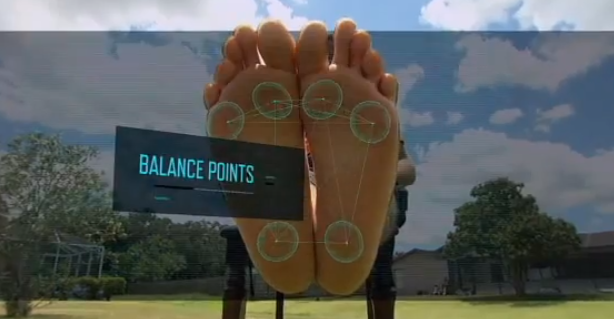
The key to walking on a high-wire is the heel! So says this ESPN video by John Brenkus and the Sport Science team that analyzes the biomechanics and physics behind Nik Wallenda’s successful high-wire walk across Niagara Falls
Typically, the foot is supported by three main balance points. But on a narrow surface like a high-wire, you have only two balance points. This makes the heel 50 percent of the equation. The heel is also the part of the foot most sensitive to vibrations (caused by the gently oscillating high-wire); the heel has nerve endings that respond as fast as .0006 seconds. That’s more than 16 time faster than the brain processes visual stimuli.
What’s so fascinating about this Sports Science video is what runners –and walkers– can learn about how the human body moves, whether it’s on a vertigo-inducing two-inch high-wire nearly 200 feet above rushing waters, or going out for a run or hike. The take-away message? It all begins with the foot. The less interference there is between the sole and the surface it is encountering, the more efficient will be the body’s natural reaction to moving forward. By creating an artificial barrier such as wearing thick-soled, big-heels shoes, you thereby reduce what is called proprioception. As a result, your body has to make unnecessary readjustments, which affects the stride. –Bill Katovsky

Wow, this is EXACTLY what happens in running, just not in a way that immediately poses risk. The foot MUST feel the ground to stabilize you quickly. Proprioception is really FAST. plently of folks out there have strong cores that still do not have this essential timing. so get thinner in your shoes and retrain the proprioception. set up a mini balance rope in your back yard for summer fun….I’m going to.
Mark
Do you have any idea what you are talking about? How do thick sole shoes actually interfere with proprioception? There are no proprioceptive sensors in the sole of the foot! Do you even know what proprioception is? Proprioceptive sensors are only found around joints, and do not exist in the sole of the foot! Someone needs to go back to school to learn about basic neurophysiology.
Peter,
Great question and debate. Here is my opinion based on the science and human experience. We know from the mapping of the homunculus that the fingers, ball of foot, and lips have the most sensory input to the brain. The feet and hands communicate joint position and allow for the unconscious adjustments that occur in the entire kinetic chain. The messengers are everywhere, and especially strong in the joints themselves and at the hands and feet. Like they say “the foot bone’s connected to the ankle bone, the ankle’s connected to the shin bone….”
Proprioceptors are tiny little nerve endings in our bodies that help with balance and setting muscle tension. When we walk lots little things that must take place to get from point A to point B without falling. The eyes play a key role along with our vestibular system (inner ear system that regulates balance) in helping us maintain balance. The little nerve endings in our hands and feet that tell our muscles and the rest of the body exactly where we are in position, space and time. Now close your eyes and touch your nose with your finger. because of proprioceptors. Those little nerve endings (proprioceptors) know where your arm is in space allowing you to perform the desired action. Now stand on one foot and get your balance. This is challenging for most folks. Now close your eyes while standing on one foot. When your eyes are closed, you are relying only on proprioceptors for balance. Your foot may be shaking from side to side. That shaking is coming from the little nerve endings firing away to maintain balance.
Whenever we step, the nerve endings are performing just like when your eyes were closed, but we fail to notice this because of our visual and vestibular input. We don’t fall over because those nerve endings recognize that we are on solid ground and our muscles adjust appropriately. Proprioceptors act like a balance pole used with walking a tightrope. It helps maintain a stable center of gravity. If we are falling to the right, the pole balances the left and vise versa. Poor proprioceptive activity leaves the body walking a tightrope without a pole. For the elderly and unstable of gait with no safety net, this leads to fractured bones and other various injuries.
In my clinical practice we see the elderly fall. When we get older or have an injury, our proprioceptors become less reactive. We might attribute the fall to them becoming “light headed”, but often this is due to proprioceptors failing to communicate properly. If they fail to fire when they are supposed to, the body can’t tell the difference from flat ground versus uneven ground.
A young person with a sprained ankle exhibits similar dysfunction. The proprioceptors fail to provide stability and even ground can be a dangerous unstable environment. With each step, certain muscle fibers have to relax and contract due to the surface beneath it. This happens automatically, unless we have flaws in our neuromuscular system. All it takes is slight misfiring and we can lose balance or have a joint suddenly give way making us prone to injury.
Proprioceptors can be retrained at any age and improved upon. Balance training and exercise can improve proprioceptors in a very short time. This is especially relevant in the elderly and the athlete, 2 groups who are putting themselves at risk daily. The footwear masks the proprioception.
A good article from Robbins is here
http://ageing.oxfordjournals.org/content/24/1/67.short
as is this one from Irene Davis’s team
http://www.asbweb.org/conferences/2011/pdf/344.pdf
the effect of footwear on diabetics
http://www.ncbi.nlm.nih.gov/pubmed/18357582
tai chi and ankle/knee stability
http://www.msscentershop.info/content/38/1/50.abstract
Dr. Mark